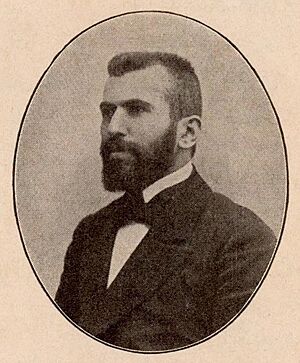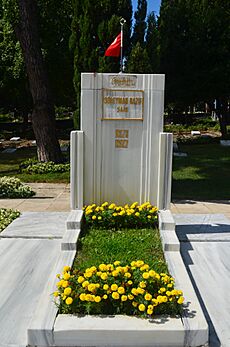Süleyman Nazif facts for kids
Quick facts for kids
Süleyman Nazif
|
|
|---|---|
 |
|
| Personal details | |
| Born | 29 January 1870 Diyarbakır, Ottoman Empire |
| Died | 4 January 1927 (aged 56) Istanbul, Turkey |
| Nationality | Turkish |
Süleyman Nazif (born 29 January 1870 – died 4 January 1927) was an important Turkish poet and writer. He was also a key member of a political group called the CUP. Süleyman Nazif was very good at languages. He knew Arabic, Persian, and French. He worked for the government during the time of Sultan Abdul Hamid II. He wrote for a magazine called Servet-i Fünun ("Wealth of Knowledge"). This magazine was later stopped by the government in 1901.
Contents
About Süleyman Nazif
Süleyman Nazif was born in 1870 in Diyarbakır, a city in the Ottoman Empire. His family was Kurdish. His father, Said Pasha, was also a poet and a historian. Süleyman Nazif was the brother of another famous Turkish poet and politician, Faik Ali Ozansoy.
Süleyman Nazif started his education very early in Maraş. He later went to school in Diyarbakır. In 1879, he joined his father again in Maraş. He took private lessons from his father. He also learned French from an Armenian priest.
Early Career and Writing
After his father passed away in 1892, Süleyman Nazif worked in different jobs for the government in Diyarbakır. In 1896, he got a promotion and worked for a while in Mosul.
Later, he moved to Constantinople (now Istanbul). There, he began to write articles against Sultan Abdul Hamid II. He supported the ideas of a group called the Young Ottomans. In 1897, he left Istanbul and moved to Paris. In Paris, he wrote for a newspaper called Meşveret. This newspaper was started by Ahmet Rıza. Süleyman Nazif also joined the Committee of Union and Progress while in Paris. He stayed in Paris for about eight months.
When he came back home, he had to work as a secretary in the government of Bursa. In 1908, Süleyman Nazif moved to Istanbul again. He rejoined the Committee of Union and Progress. He also started a newspaper called Tasvîr-i Efkâr with the well-known journalist Ebüzziya Tevfik. Even though this newspaper closed quickly, his articles made him a famous writer.
Public Service and Humanitarian Efforts
After Sultan Abdülhamid II brought back the constitutional monarchy in 1908, Süleyman Nazif became a governor. He served in several Ottoman provinces. These included Basra (1909), Kastamonu (1910), Trabzon (1911), Mosul (1913), and Baghdad (1914). However, he decided in 1915 to leave government work. He wanted to go back to being a writer.
During his time as governor of Baghdad, Nazif worked to prevent terrible events from happening. He tried to protect people who were being forced to leave their homes. In one case, he tried to help a group of 260 Armenian women and children. He asked for them to be moved to a safer place, but his request was not accepted.
Nazif also visited Diyarbakir. He was very upset by what he saw there. He strongly criticized Dr. Mehmed Reshid, who was the governor of Diyarbakir. Nazif said that Reshid caused great harm to many people. He also wrote about a group that Reshid had created. This group had its own military unit. Nazif also encouraged other governors not to follow harmful orders. He wrote a letter to his brother, Faik Ali Bey, who was the governor of Kutahya. In the letter, Nazif told him, "Don't participate in this event, watch out for our family's honor."
Later Life and Legacy
On November 23, 1918, Nazif wrote an article called Kara Bir Gün (meaning A Black Day). It was published in the newspaper Hadisat. This article criticized the French forces occupying Istanbul. Because of this article, the French commander ordered Nazif to be executed. However, the order was later cancelled.
On January 23, 1920, Süleyman Nazif gave a speech. He was honoring the French writer Pierre Loti. After this speech, the British military, who were occupying Istanbul, forced Süleyman Nazif to go into exile on Malta. He stayed in Malta for about twenty months. During this time, he wrote a novel called Çal Çoban Çal. After the Turkish War of Independence, he returned to Constantinople. He continued to write.
Nazif often criticized European powers. He wrote two articles that caused a lot of discussion. One was "Hazret-i İsa'ya Açık Mektup" (Open Letter to Jesus). In it, he described the actions of some European countries. Two weeks later, he published "The Reply of Jesus." In this article, he wrote as if Jesus was speaking. He argued that he was not responsible for the actions of some Christians. These letters caused a stir. Nazif was almost put on trial. In the end, he apologized, but he continued to criticize what he called the "Crusader mentality" of European powers. He believed they were trying to gain more power in Turkey.

Süleyman Nazif passed away from pneumonia on January 4, 1927. He was buried at the Edirnekapı Martyr's Cemetery in Istanbul.
See also
- Witnesses and testimonies of the Armenian genocide

